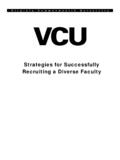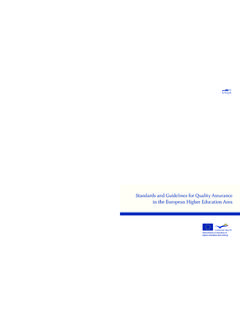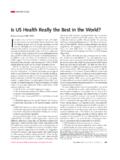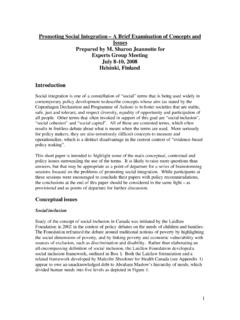Transcription of Loraleigh Keashly Wayne State University Joel H. …
1 Faculty Experiences with Bullying in Higher Education Causes, Consequences, and Management Loraleigh Keashly Wayne State University joel H. Neuman State University of New York at New Paltz ABSTRACT. Although much research has been done on workplace aggression and bullying over the past two decades, academics have paid relatively little attention to bullying in their own institutions. In this article, we discuss what is currently known about bullying in academia, with a particular focus on faculty behavior, and apply empirical and conceptual findings from research on aggression and bullying in other work settings and the significant literature on conflict management in higher education. We begin by describing the nature and prevalence of aggression and bullying in higher education. Drawing on well-established findings from interper- sonal aggression research, we discuss several important social, situational, and contextual antecedents to aggression (includ- ing academic culture, climate, values, and work practices) and demonstrate how these may serve as causes and consequences of bullying.
2 Embedded in this discussion, we offer a number of specific propositions for future research. We conclude with a discussion of possible actions for prevention and management of bullying in higher educational settings. In the 1990s, researchers began to discuss, and explore, bullying among adults in work settings (Leymann, 1990). For the better part of the past two decades, a growing number of researchers (ourselves included) have been conducting research on this and related phenomena ( , workplace aggres- sion and violence, mobbing, emotional abuse, etc.). Surprisingly, University - Administrative Theory & Praxis / March 2010, Vol. 32, No. 1, pp. 48 70. 2010 Public Administration Theory Network. 1084-1806 / 2010 $ + 48 DOI Keashly & neuman 49. based researchers have paid relatively little attention to bullying in their own backyards.
3 This is an interesting oversight for a number of reasons. First, it stands in contrast to reliable evidence of other forms of hostile and demeaning behaviors on campus such as student and faculty incivility in the classroom ( , Braxton & Bayer, 2004). Second, the quality of interpersonal relations, such as collegiality, is an important factor in retention of faculty (Norman, Ambrose, & Huston, 2006). Third, the extensive literature on conflict and misconduct in higher education (Cameron, Meyers, & Olswang, 2005; Eu- ben & Lee, 2006; Holton, 1998) highlights the structural and interpersonal opportunities for disagreement and potentially for hostility in such settings. Finally, the academic environment has a number of organizational and work features that increase the likelihood of hostile interpersonal behaviors (Neu- man & Baron, 2003; Twale & De Luca, 2008).
4 While academics have paid little systematic empirical research atten- tion to bullying in academic settings, this has not been the case in several popular online outlets and more traditional trade publications. For example, and .html represent some online destinations. In terms of a respected industry . publication, the Chronicle of Higher Education has published numerous articles recently on the hostility and mistreatment that occurs on campuses ( , Fogg, 2008; Gravois, 2006). This suggests that academic settings are worthy and in need of concerted attention by researchers in workplace ag- gression and bullying. In this article, we attempt to address this deficiency. First, we will briefly outline important findings about the nature, prevalence, and effects of bullying, aggression, and related phenomena.
5 Next, we discuss several well-established causes of aggression and bullying and demonstrate how these antecedents are commonly manifested in (and endemic to) academic We will draw upon the extensive theoretical and empirical literature on interpersonal ag- gression, conflict in higher education, and related areas and use these findings to offer a number of concrete propositions for future research on bullying in higher education. We conclude by providing some suggested actions for ad- dressing such behavior that flow from our analysis. As our point of departure, we adopt the following definition of workplace bullying: Bullying at work means harassing, offending, socially excluding some- one or negatively affecting someone's work tasks.. It has to occur repeatedly and regularly ( , weekly) and over a period of time ( , at least six months).
6 Bullying is an escalating process in the course of which the person confronted ends up in an inferior position and becomes the target of systematic negative social acts. (Einarsen, Hoel, Zapf, &. Cooper, 2003, p. 15). 50 Administrative theory & praxis v Vol. 32, No. 1. A central premise of this article is that workplace bullying (also referred to as mobbing in some literature) represents acts of workplace aggression efforts by individuals to harm others at work (Neuman & Baron, 2005). Thus, theories of aggression and conflict serve as the theoretical bases of our presentation. BULLYING IN HIGHER EDUCATION: PREVALENCE, NATURE, AND EFFECTS. A comprehensive review of all the relevant literature specific to all aspects of bullying in academia is not possible given the space constraints of this article.
7 Such a discussion would have to include a variety of actors and targets ( , students, staff, and administrators) as well as assorted (or unique) forms of bullying ( , cyberbullying). Consequently we have chosen to focus our attention on faculty experiences and behavior, as they are important deter- minants of organizational culture and climate well-established antecedents and consequences of aggression and bullying. We have summarized a number of relevant studies in Table 1. Review of Table 1 reveals several interesting observations. First, the rates of bullying seem relatively high when compared to those noted in the general population, which range from 2% to 5% in Scan- dinavian countries, 10% to 20% in the UK, and 10% to 14% in the United states ( Keashly & Jagatic, in press; Rayner & Cooper, 2006).
8 The presence of witnesses is notable as an indicator of the climate within an organization that others in the environment are aware of and harmed by these experiences. These individuals could play a very helpful role in the prevention and management of aggression and bullying, as discussed below. The nature of the relationship between actors and targets is also notable. As power differences can be a defining feature of bullying, it is not surprising to find supervisors and administrators often identified as actors. However, in our recent study conducted with University employees ( Keashly & Neuman, 2008), colleagues were more likely to be identified as bullies by faculty ( ), while superiors were more likely to be identified as bullies by frontline staff ( ). Contrary to the current emphasis on student incivility, faculty concern about workplace harassment was more likely to be associated with colleagues (especially senior colleagues) and superiors much more frequently than with students.
9 These findings support the importance of focusing on faculty be- haviors in understanding bullying in academic settings. Another observation is that the experiences reported involved two or more actors, that is, mobbing. Westhues (2004), in discussing the mobbing of pro- fessors by their colleagues and administrators, has argued that the experience of being mobbed is very different from the experience (however upsetting) of being harassed by a single actor. In our 2008 sample, we found that rates of mobbing differed as a function of the occupational group being studied. Fac- ulty members were almost twice as likely as staff to report being the victims Table 1. Studies of aggression and bullying in academic settings Study Sample Time frame Rates Actors Bj rkqvist, 1994 Employees at one University ; Prior 6 months Experienced: Superior: finland N = 338 (47% response rate) Witnessed: 32% Peer: Subordinate: Keashly & neuman Lewis, 1999 Further/higher educa- Not reported Experienced: 18% Not asked Wales tion union members; 32 Witnessed: 22%.
10 Institutions; N = 415 ( response rate). Kinman & Jones, 2004 Members of University Not reported Experienced: 18%; Not asked UK Teachers Association; 99. institutions; N = 1100 (22%. response rate). Simpson & Cohen, 2004 Employees at one University ; Not reported Experienced: 25% Superior: 80%. UK ( response rate) Witnessed: 33% Peer: 20%. Times Higher Education Self-selected sample of Not reported Experienced: 42% Manager: 49%. Supplement, 2005 higher education employees; Witnessed: 72% Senior to victim (not mgr): UK N = 843 26%. 1 bully: 61%. >1 bully: 39%. Raskauskas, 2006 Higher education employees, Previous year Experienced: Superior: New Zealand 7 institutions; N = 1117 Of these, report 1 2 Peer: incidents; report 10 1 bully: incidents 2 bullies: 5 bullies: 51. (continues). Table 1.







